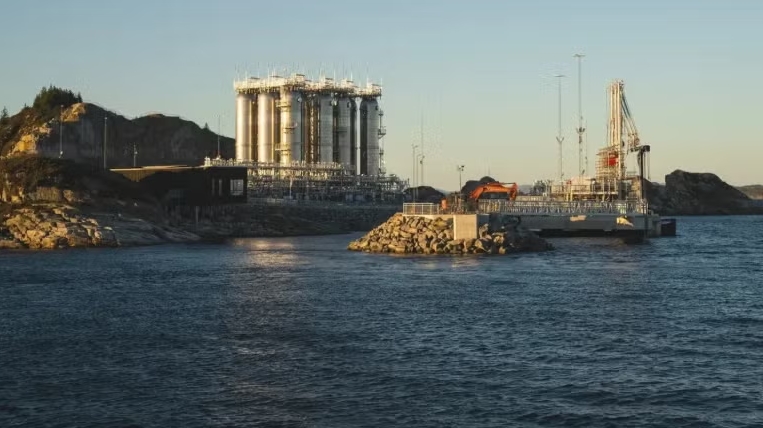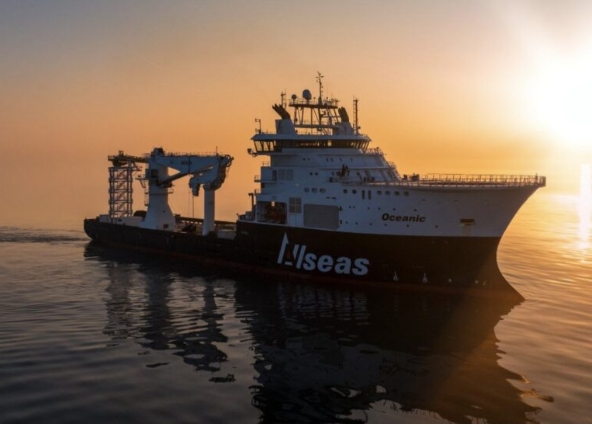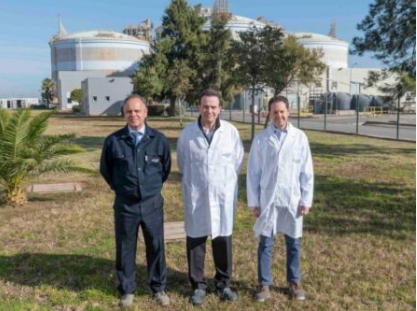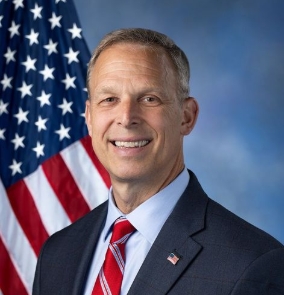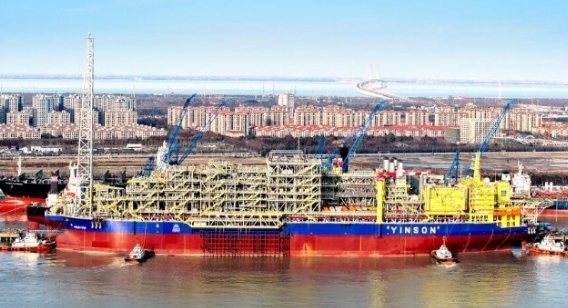Another upcoming project, pegged at a cost of $900 million, is the Alberta Carbon Trunk Line, which will capture CO2 at a fertilizer plant and a refinery near Edmonton and send it 240 km via a pipeline to mature oilfields near Clive, Alberta, where it will then be injected underground to facilitate oil recovery. The process will sequester so much CO2 – up to 1.8 megatonnes annually – that, at full capacity, it will have the same effect as taking 339,000 cars off the road each year, according to Natural Resources Canada. (A megatonne is one million tonnes or one billion kilograms.)
Although aspects of CCS technology sound futuristic, the technology is actually not new. The concept of capturing CO2 and preventing it from escaping into the atmosphere was initially proposed in 1977, and the first CCS projects began in the late 1990s. Rick Chalaturnyk, a professor of civil and environmental engineering at the University of Alberta, worked on CCS proposals connected with the power industry in the early 2000s. He says there was great enthusiasm about the potential of CCS, but that initial momentum was ultimately derailed by concerns about runaway costs. However, recent scientific advancements and fresh strategies have altered perceptions.
“The number of projects has been exploding,” says Dr. Chalaturnyk. He notes that when companies in the natural gas, coal, hydrogen and other industrial sectors propose new projects to regulatory agencies and governments today, “there is always a CCS component.”
Several Canadian universities are now engaged in CCS research. Most of this work is on specific aspects of the technology and is being conducted in partnership with industry and government. The goals are not just to come up with scientific breakthroughs, but also to train a new crop of young scientists in this growing field.
At the Clean Energy Centre at the University of British Columbia, scientists are trying to find better sorbents to absorb CO2 from the flue gas that comes out of smokestacks, says Naoko Ellis, a professor of chemical and biological engineering at UBC. In typical industrial applications, capturing the CO2 represents about 70 percent of the cost of a CCS project, so there is considerable motivation to improve the effectiveness of the materials being used. However, the quest to find better sorbents involves a continual tradeoff, as new materials may enhance capture but are often more expensive.
Another key challenge with this type of work is ensuring that discoveries made within the confines of the laboratory maintain their viability when they are scaled up for industrial applications. “There are lots of solutions in a beaker. It’s tougher when you’re dealing with the production of tonnes of CO2 per day,” says Dr. Chalaturnyk.
A few facts about CO2
Fact 1: In North America, CO2 is the main greenhouse gas (GHG) emitted into the atmosphere, accounting for 79 percent of Canada’s total GHGs.
Fact 2: It is estimated that carbon capture and storage technologies can capture more than 90 percent of CO2 emissions from power plants and industrial facilities.
Fact 3: In May 2019, CO2 levels in our atmosphere reached 415 parts per million for the first time in human history. The last time CO2 levels were this high was probably 2.5 to 5 million years ago, when temperatures were 2˚ to 3˚C higher than today.
Fact 4: Human activities are currently putting 42 billion tonnes of CO2 into the atmosphere each year. A path that would prevent a rise of much more than 1.5°C would require annual emissions to fall by about 50 percent between now and 2030, and reach net zero emissions by 2050.
Of course, once the CO2 is in the ground, it needs to stay there. That’s the objective of the Containment and Monitoring Institute (CaMI) field research station, which stands on a 220-hectare site near Brooks, Alberta. One of the first facilities dedicated to carbon capture and storage monitoring and training in Canada, this $7-million project is run through a partnership between CMC Research Institutes and the University of Calgary, with operational funding supplied by the Canada First Research Excellence Fund and additional support provided by several multinational companies.
The station aims to develop and demonstrate technologies to monitor CO2 and other fluids stored in underground reservoirs. “It’s a key issue for CCS implementation on a commercial scale, assuring the public and regulators that it’s safe,” says U of C’s Dr. Lawton, who is the research station director. “Our goal is to find the best technologies to ensure that after injecting CO2 it doesn’t bubble up but stays underground and we know where it is.”
At the site, CO2 is injected into a reservoir 300 metres underground, where it remains in a gaseous state (it turns liquid at greater depths). The injection well is surrounded by two observation wells and four water-monitoring wells to allow researchers to test a variety of technologies.
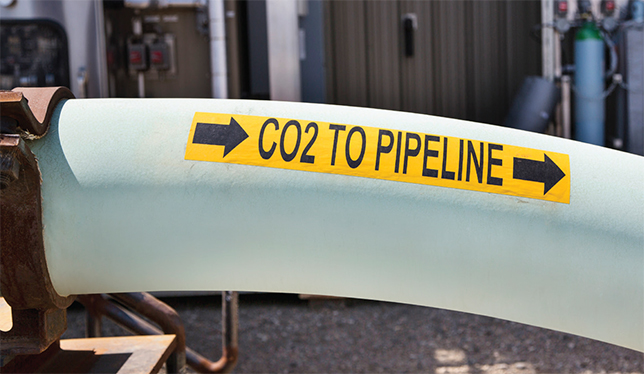 The CO2 injection pipeline. Photo courtesy of Shell Canada Limited.
The CO2 injection pipeline. Photo courtesy of Shell Canada Limited.
“Canada is a leader in storage technology. Over a million tonnes of CO2 is being stored per year in Alberta alone,” notes Dr. Lawton, who views CCS as a bridge technology that can help to achieve significant reductions in the amount of CO2 being released into the atmosphere. “We’re not able to move directly to renewables yet. Most estimates indicate we will still be dependent on fossil fuels until 2050 or 2060.”
One drawback to the widespread adoption of CCS technology is that unless significant tax credits are made available by governments, there is currently little financial incentive to employ the technology. A possible solution is to find new commercial uses for the captured CO2, rather than just pumping it underground, such as in the manufacture of products like concrete, chemicals and soaps. This would not only cut emissions but help to subsidize the costs of the conversion process. McKinsey & Company, a global management consulting firm, estimates that by 2030, CO2-based products could be worth between $800 billion and $1 trillion, and the use of captured CO2 for producing fuel, enriching concrete and generating power alone could slash greenhouse gas emissions by a billion tonnes yearly.
As mentioned, captured carbon dioxide is also being used to improve oil recovery. Typically, only about 30 percent of an oil deposit is recovered at well sites during the primary drilling process. Injecting CO2 into abandoned well sites can increase that to 60 percent by pushing the petroleum to a production wellbore while reducing its viscosity and boosting its flow rate.
Enhanced oil recovery is now enjoying a revival in the U.S. in response to changes brought in under President Donald Trump’s major tax reform, which granted credits of $30 per tonne for CO2 used for this type of oil recovery. Those tax changes increase the viability of using CO2 in enhanced oil recovery schemes and could revive projects that have stalled.
But even if enhanced oil recovery makes CCS more economically attractive, there remains the question of how many such plants are needed to have a significant global impact. The answer is sobering – about 4,000, say experts. At present, there are only 18 large-scale CCS plants in operation worldwide, according to the Global CCS Institute.
It is also sobering to realize that the construction of even thousands of CCS plants won’t entirely solve the problem of rising CO2 levels in the atmosphere. That’s because these facilities will have no impact on the emissions generated by the transportation sector. The Environmental Protection Agency in the U.S. says transportation accounts for about 29 percent of greenhouse gas emissions in that country; the estimates for Canada are similar.
Nor will CCS technology solve the problem of “legacy emissions” – the billions of tonnes of CO2 that humanity has already expelled into the sky since the start of the modern industrial era. Scientists say that the concentration of CO2 in the atmosphere reached a global average of 410 parts per million in 2018. Prior to the Industrial Revolution, the global average is gauged to have been about 280 ppm.
In order to meet the goal of the Paris Agreement of holding a rise in global temperatures to below 2°C, total greenhouse gas emissions need to drop 55 percent by 2030, according to a 2018 United Nations report. Overall, the report suggests that nations would need to triple their current climate action pledges to reach a 2°C target and increase their efforts fivefold to reach the 1.5°C target. “People really don’t understand the scope of what is required to hit the targets of the Paris Agreement,” says Chris Bataille, an energy and climate policy researcher with the Canadian Energy and Emissions Data Centre at Simon Fraser University.
A reluctance to aggressively tackle the problem has exacerbated the challenges we now face. “Essentially, we’ve waited too long to get around to reducing carbon emissions. Even if we waved a magic wand and all the vehicles, all the lights and everything were suddenly being run from renewable energy, we would still need to be removing CO2 from the atmosphere,” says Steven Bryant, a professor of chemical and petroleum engineering at U of C and holder of the Canada Excellence Research Chair in Materials Engineering for Unconventional Oil Reservoirs.
The realization that reducing emissions alone won’t be enough to slow the rise of global temperatures has given impetus to a groundbreaking and controversial technology known as direct air capture (DAC). “In the past it was regarded as a crazy fringe activity,” says Dr. Bryant, “but now it’s showing some potential.”
The process, one version of which involves collecting air with giant fans and then pushing it through a filter where a liquid solvent absorbs the CO2, is appealing in that collectors can be placed anywhere one chooses. But, gathering large amounts of CO2 from the air is difficult. This is because the concentration of CO2 in the atmosphere (now more than 400 parts per million) is a hundred times less than its concentration in the flue gas of an industrial plant.
Even so, one Canadian company has been aggressively pursuing the technology. Carbon Engineering Ltd. has been retrieving CO2 from the atmosphere at a pilot plant in Squamish, B.C., since 2015 at a rate of about 1,000 tonnes per day. The company employs renewable energy to split water into hydrogen and oxygen through co-electrolysis. The hydrogen and captured CO2 are then recombined to form syngas, or synthesis gas, which can be transformed into hydrocarbon fuels such as diesel or gasoline.
David Keith, a former University of Calgary professor, founded Carbon Engineering in 2009 after a debate with one of his students, who insisted that large-scale collection of CO2 from the air was impossible because of prohibitive costs. Dr. Keith, who now heads the company’s board of directors and is a professor of engineering at Harvard University, claims that DAC can be done more cheaply than previously believed – down from $1,000 per tonne to between $94 and $232 per tonne. He also believes that the technology will look more attractive to industry as governments increase the penalties for emitting carbon into the atmosphere.
Dr. Keith’s visionary ideas have attracted heavyweight backers, including an initial US $30-million investment from a group that included billionaire Bill Gates and Canadian oil magnate Murray Edwards. In March 2019, Carbon Engineering announced that it had raised another US $68 million from a cadre of investors that include mining giant BHP, Chevron Corp., Occidental Petroleum Corp., and Canadian billionaire Peter J. Thomson. This represents the largest private investment in any direct air capture company to date. In June 2019, Carbon Engineering landed another $25-million cash infusion from the Government of Canada.
Carbon Engineering plans to earn fees by designing and helping to build the plants and then collecting millions of dollars annually in royalties as they enter production. The company provides several options for its customers, including storing the CO2 underground or using it to produce carbon-neutral fuel or other materials.
Despite the progress, not everyone is convinced about the merits of CCS. Laurie Adkin, a professor in the department of political science at U of A, says she doesn’t believe that CCS and other “clean energy” technologies, which governments are heavily subsidizing on behalf of the fossil fuel industry, are an answer to the climate crisis. “They are primarily a legitimation strategy intended to prolong fossil fuels extraction and the demand for fossil fuels,” she says, adding that the same amounts of money, if invested in renewable energy and energy efficiency, would achieve more and pose fewer risks.
“The oil and gas industry is putting all kinds of eggs in the basket of ‘clean technology’ or ‘clean energy.’ They are claiming that oil and gas extraction and upgrading can even become zero-emission,” she says. “But what about the emissions produced when the exported oil and gas are combusted somewhere else? That alone blows the remaining global carbon budget. I can’t see any way around this reality. We’re at the end of fossil fuels, unless we plan to burn down our home.”
Dr. Adkin’s views are echoed by Kevin Anderson and Glen Peters, two leading climate scientists who argued in a 2016 editorial in the journal Science that, if we rely on carbon capture technologies and they are unsuccessful at removing CO2 from the atmosphere at the proposed levels, then society will be locked into a high-temperature trajectory. “Negative-emission technologies are not an insurance policy,” they write, “but rather an unjust and high-stakes gamble.”
But, supporters of CCS insist the technology is critical for the interim period as we try to solve the issues of energy storage and pursue the goal of moving to renewables. Dr. Bryant says he’s convinced that CCS can be a valuable tool in the fight to slow climate change, but he feels it’s only part of the answer.
“There is no silver bullet. We’ll have to employ a large number of different technologies and reduce the overall demand for energy,” he says. “We also need to be implementing technologies that actively take CO2 out of the atmosphere, or else our grandchildren are really going to be having an unpleasant time of it. We owe it to them to start doing it now. History will not treat our generation kindly if we kick the can of responsibility for this down the road.”

